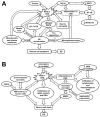Inflammaging and Oxidative Stress in Human Diseases: From Molecular Mechanisms to Novel Treatments
- PMID: 31510091
- PMCID: PMC6769561
- DOI: 10.3390/ijms20184472
Inflammaging and Oxidative Stress in Human Diseases: From Molecular Mechanisms to Novel Treatments
Abstract
It has been proposed that a chronic state of inflammation correlated with aging known as inflammaging, is implicated in multiple disease states commonly observed in the elderly population. Inflammaging is associated with over-abundance of reactive oxygen species in the cell, which can lead to oxidation and damage of cellular components, increased inflammation, and activation of cell death pathways. This review focuses on inflammaging and its contribution to various age-related diseases such as cardiovascular disease, cancer, neurodegenerative diseases, chronic obstructive pulmonary disease, diabetes, and rheumatoid arthritis. Recently published mechanistic details of the roles of reactive oxygen species in inflammaging and various diseases will also be discussed. Advancements in potential treatments to ameliorate inflammaging, oxidative stress, and consequently, reduce the morbidity of multiple disease states will be explored.
Keywords: COPD; cancer; cardiovascular disease; diabetes; neurodegenerative disease; reactive oxygen species; rheumatoid arthritis.
Conflict of interest statement
The authors declare no conflict of interest.
Figures







References
-
- Xu J., Murphy S.L., Kochanek K.D., Arias E. Mortality in the United States, 2015. [(accessed on 5 January 2019)];NCHS Data Brief. 2016 :1–8. Available online: http://www.ncbi.nlm.nih.gov/pubmed/27930283. - PubMed
-
- Jin K. Modern Biological Theories of Aging. [(accessed on 9 June 2019)];Aging Dis. 2010 1:72–74. Available online: http://www.ncbi.nlm.nih.gov/pubmed/21132086. - PMC - PubMed
-
- Sergiev P.V., Dontsova O.A., Berezkin G.V. Theories of aging: An ever-evolving field. [(accessed on 11 November 2018)];Acta Nat. 2015 7:9–18. doi: 10.32607/20758251-2015-7-1-9-18. Available online: http://www.ncbi.nlm.nih.gov/pubmed/25926998. - DOI - PMC - PubMed
-
- Salvioli S., Monti D., Lanzarini C., Conte M., Pirazzini C., Bacalini M.G., Garagnani P., Giuliani C., Fontanesi E., Ostan R., et al. Immune system, cell senescence, aging and longevity--inflamm-aging reappraised. [(accessed on 6 May 2019)];Curr. Pharm. Des. 2013 19:1675–1679. Available online: http://www.ncbi.nlm.nih.gov/pubmed/23589904. - PubMed
Publication types
MeSH terms
Substances
Grants and funding
LinkOut - more resources
Full Text Sources
Medical

